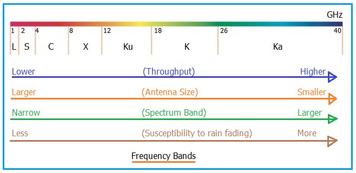
Acousto Optic Tunable Filter (AOTF) Basics
Explore the basics of Acousto Optic Tunable Filters (AOTF), their operation in optical networks, and their application in Wavelength Selective Switches (WSS).
Showing 25 posts (Page 1 of 2)
Advertisement

Explore the basics of Acousto Optic Tunable Filters (AOTF), their operation in optical networks, and their application in Wavelength Selective Switches (WSS).

Learn about agile optical switches, their functions in fiber optic systems, and their role in dynamically reconfiguring DWDM networks for enhanced service deployment.

Calculate the antenna near field distance based on antenna dimensions and signal wavelength. Useful for determining the start of the far field region.

Explore the functionality of dichroic filters, precision color filters used in WDM networks to selectively pass or reflect specific wavelengths of light.

Explore the electromagnetic spectrum: frequencies, wavelengths, sources, and applications of EM waves, including radio, microwave, infrared, visible light, and more.

Convert between frequency and wavelength using our online converter. Calculate wavelength from frequency or frequency from wavelength.
Explore the distinctions between Infrared (IR) and Ultraviolet (UV) radiation, including frequency, wavelength, advantages, and disadvantages for various applications.

Explore the infrared (IR) spectrum, its subdivisions, and a frequency table for infrared communication, covering wavelengths and applications.

Explore the L band's frequency range (1-2 GHz), wavelength (15-30 cm), applications in communication, advantages, and disadvantages in various industries.
Explore the LiFi frequency spectrum, including visible light, UV, and IR, and understand the relationship between wavelength and data transmission rates.

Understand the distinctions between millimeter wave (mmWave) and microwave frequencies, including applications, bandwidths, resolution, and advantages.

Learn about optical filters, including their function, types (long pass, short pass, band pass), and key specifications like bandwidth and isolation.

Explore optocouplers: their function in optical networks, types (wavelength-selective/independent), and key features like high isolation and low power loss.
Understand photodetector responsivity, a measure of electrical output per optical input, crucial in fiber optic systems. Learn about factors affecting it.

Calculate photon energy using the E=hv formula. Understand the relationship between energy, frequency, and wavelength with our easy-to-use calculator.

Calculate phase velocity, wavelength, and wave impedance for plane waves in unbound materials. Input relative permittivity, permeability, and frequency.
Learn essential radar terminology, including frequency, phase, bandwidth, pulse width, PRF, PRT, duty factor, beam width, and radar reflectivity.

Calculate the wavelength of a radio frequency (RF) signal using this online calculator. The formula and example are provided for easy understanding.

Explore the differences between WB, PLC, WSS, and WXC ROADM types used in fiber optic networks, including configurations, advantages, and disadvantages.

Explore the S band frequency range (2-4 GHz), its applications in radar and satellite communication, and its advantages and disadvantages.

Calculate the effective dielectric constant and guide wavelength of a slotline using our online calculator. Get accurate results for your design needs.

Calculate the TEM wavelength given the frequency and relative permittivity. Useful for transmission line design.

Learn about tunable lasers, their function in fiber optic networks, and how they allow continuous adjustment of emission wavelength for optimal transmission.
Explore the frequencies and wavelengths of visible light colors: red, orange, yellow, green, blue, and violet.
WDM is a multiplexing technique that transmits different light signals with unique wavelengths through fiber optic cables, increasing data rate capacity. It's similar to FDM but operates on light signals.
Advertisement